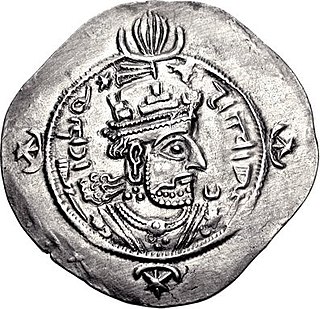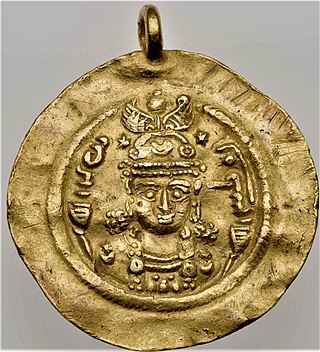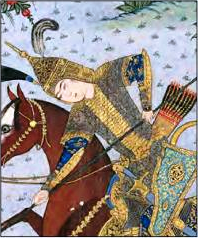
Kavad II was the Sasanian King of Kings of Iran briefly in 628.

Khosrow II, also known as Khosrow Parviz, is considered to be the last great Sasanian king (shah) of Iran, ruling from 590 to 628, with an interruption of one year.

Yazdegerd III was the last Sasanian King of Kings of Iran from 632 to 651. His father was Shahriyar and his grandfather was Khosrow II.

Boran was Sasanian queen of Iran from 630 to 632, with an interruption of some months. She was the daughter of king Khosrow II and the Byzantine princess Maria. She is the second of only three women to rule in Iranian history, the others being Musa of Parthia, and Boran's sister Azarmidokht.

Rostam Farrokhzād was an Iranian dynast from the Ispahbudhan family, who served as the spahbed of the northwestern quarter (kust) of Adurbadagan during the reign of Boran and Yazdegerd III. Rostam is remembered as a historical figure, a character in the Persian epic poem Shahnameh, and as a touchstone of most Iranian nationalists.

Azarmidokht was Sasanian queen regnant (banbishn) of Iran from 630 to 631. She was the daughter of king (shah) Khosrow II. She was the second Sasanian queen; her sister Boran ruled before and after her. Azarmidokht came to power in Iran after her cousin Shapur-i Shahrvaraz was deposed by the Parsig faction, led by Piruz Khosrow, who helped Azarmidokht ascend the throne. Her rule was marked by an attempt of a nobleman and commander Farrukh Hormizd to marry her and come to power. After the queen's refusal, he declared himself an anti-king. Azarmidokht had him killed as a result of a successful plot. She was, however, killed herself shortly afterwards by Rostam Farrokhzad in retaliation for his father's death. She was succeeded by Boran.

Hormuzan was a Persian aristocrat who served as the governor of Khuzestan, and was one of the Sasanian military officers at the Battle of al-Qādisiyyah. He was later taken prisoner by the Muslims after the fall of Shushtar in 642. Two years later, he was accused of the assassination of the Rashidun caliph Umar, and was killed by 'Ubaid-Allah, the deceased caliph's son.

The Battle of al-Qadisiyyah was an armed conflict which took place in 636 CE between the Rashidun Caliphate and the Sasanian Empire. It occurred during the early Muslim conquests and marked a decisive victory for the Rashidun army during the Muslim conquest of Persia.
Farrukhzad, was an Iranian aristocrat from the House of Ispahbudhan and the founder of the Bavand dynasty, ruling from 651 to 665. Originally a powerful servant of the Sasanian king Khosrow II, he, along with several other powerful aristocrats made a conspiracy against the latter and ended his tyrannical rule. They thereafter put Khosrow's son Kavadh II on the throne, whose rule lasted only a few months, before he was killed by a plague, being succeeded by his son Ardashir III, who was only after one year murdered by the rebellious former Sasanian army chief (spahbed) Shahrbaraz, who usurped the throne.
Bahman Jādhūyah/Jādūyah, or Bahman Jādhawayh was an Iranian general of the Sasanians. He is mostly known to have led the Sasanians to victory against the Arabs at the Battle of the Bridge. The Arab Muslims referred to Bahman as Dhul Hājib. He had a reputation for being anti-Arab. He is often confused with Mardanshah, another Sasanian general.

Farrukh Hormizd or Farrokh Hormizd, also known as Hormizd V, was an Iranian prince, who was one of the leading figures in Sasanian Iran in the early 7th-century. He served as the military commander (spahbed) of northern Iran. He later came in conflict with the Iranian nobility, "dividing the resources of the country". He was later killed by Siyavakhsh in a palace plot on the orders of Azarmidokht after he proposed to her in an attempt to usurp the Sasanian throne. He had two children, Rostam Farrokhzad and Farrukhzad.
Piruz Khosrow, also known as Piruzan or Firuzan, was a powerful Persian aristocrat who was the leader of the Parsig (Persian) faction that controlled much of the affairs of the Sasanian Empire during the Sasanian civil war of 628-632. He was killed at the Battle of Nahāvand in 642.
The Sasanian civil war of 628–632, also known as the Sasanian Interregnum was a conflict that broke out after the execution of the Sasanian king Khosrau II between the nobles of different factions, notably the Parthian (Pahlav) faction, the Persian (Parsig) faction, the Nimruzi faction, and the faction of general Shahrbaraz. Rapid turnover of rulers and increasing provincial landholder power further diminished the empire. Over a period of 4 years and 14 successive kings, the Sasanian Empire weakened considerably, and the power of the central authority passed into the hands of its generals, contributing to its fall.
Mihran-i Bahram-i Razi, better simply known as Mihran Razi, was an Iranian military officer from the Mihran family. He was killed in 637 at the battle of Jalula.
Mushegh III Mamikonian was an Armenian sparapet that fought against the Arabs during the Muslim conquest of Persia. He was killed during the Battle of al-Qādisiyyah in 636.
The Battle of Waj Rudh was fought in 642/643 between the Rashidun Caliphate under Nu'man, and the Sasanian Empire under the Dailamite Muta, the Parthian Farrukhzad and Isfandiyar, and the Armenian Varaztirots. The battle was fought in Waj Rudh, a village in Hamadan. The location was precisely theorized and occurred on a road junction between Hamadan and Qazvin.
Narsi or Narse, was an Iranian nobleman who served as the Sasanian governor of Kashkar.
Kanadbak, also known as Kanara, was an Iranian nobleman, who was the kanarang during the reign of the Sasanian king Khosrau II, and various other Sasanian monarchs, which includes Yazdegerd III, the last Sasanian king.
The Battle of Kaskar was fought between the advancing forces of the Rashidun Caliphate and the Sassanian Empire in Asuristan. Following the Battle of Namaraq, the defeated Persian noblemen and governor of Kaškar, Narsi, fled back to his estates in an attempt to save his life. The Muslims soon advanced towards his estate, however, and Narsi marched out to defend it. His flanks were commanded by the sons of Vistahm, Vinduyih and Tiruyih. Rostam Farrokhzad, another Persian noblemen, also sent the commander Jalinus to assist Narsi, but he did not arrive in time. In the ensuring battle, Narsi was soundly defeated, however he and his commanders managed to escape. Jalinus soon met the Muslim force as well, but he too was defeated.

Gordiya was an influential Iranian noblewoman from the House of Mihran, who was first the sister-wife of the distinguished military leader Bahram Chobin, then the wife of the Ispahbudhan dynast Vistahm, and ultimately the wife of the last prominent Sasanian emperor, Khosrow II.










